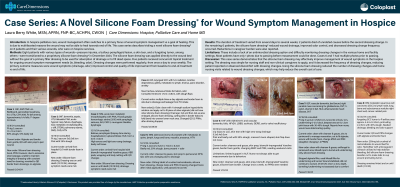Case Series/Study
(CS-015) Case Series: A Novel Silicone Foam Dressing* for Wound Symptom Management in Hospice Care
Friday, May 2, 2025
7:45 PM - 8:45 PM East Coast USA Time

Introduction: In the hospice setting, wound care is heavily focused on symptom management. This case series describes trialing a novel silicone foam dressing* on multiple patients receiving hospice services.
Methods: Eight patients experiencing various types of wounds —pressure injuries, a bullous pemphigoid lesion, a skin tear, and a fungating tumor, among others— were transitioned to a novel silicone foam dressing* in December 2024. The silicone foam dressing* was applied directly to the wound bed without a primary filler dressing. Five patients received concurrent topical treatment for additional wound symptom management (eg, bleeding, infection). Dressing changes were performed regularly, from once daily to once weekly. The primary outcomes were change in wound symptom (drainage, odor) management and change in quality of life from baseline to end-of-treatment (or end of life)
Results: The duration of treatment varied from several days to several weeks; two patients died of unrelated causes before the second dressing change. In the remaining six patients, the silicone foam dressing* reduced wound drainage, improved odor control, and decreased dressing change frequency. Reductions in caregiver burden were also reported. Limitations include lacking an antimicrobial dressing option and difficulty monitoring dressing changes in varied home settings.
Discussion: This case series demonstrates that the novel silicone foam dressing* may improve the management of wound symptoms in the hospice care setting. Dressing application was simple for nursing staff and lay caregivers, and the decreased frequency of dressing changes reduced patient discomfort. Using the silicone foam dressing* also reduced the number of home nursing visits related to dressing changes, which may reduce the overall cost of care.
Methods: Eight patients experiencing various types of wounds —pressure injuries, a bullous pemphigoid lesion, a skin tear, and a fungating tumor, among others— were transitioned to a novel silicone foam dressing* in December 2024. The silicone foam dressing* was applied directly to the wound bed without a primary filler dressing. Five patients received concurrent topical treatment for additional wound symptom management (eg, bleeding, infection). Dressing changes were performed regularly, from once daily to once weekly. The primary outcomes were change in wound symptom (drainage, odor) management and change in quality of life from baseline to end-of-treatment (or end of life)
Results: The duration of treatment varied from several days to several weeks; two patients died of unrelated causes before the second dressing change. In the remaining six patients, the silicone foam dressing* reduced wound drainage, improved odor control, and decreased dressing change frequency. Reductions in caregiver burden were also reported. Limitations include lacking an antimicrobial dressing option and difficulty monitoring dressing changes in varied home settings.
Discussion: This case series demonstrates that the novel silicone foam dressing* may improve the management of wound symptoms in the hospice care setting. Dressing application was simple for nursing staff and lay caregivers, and the decreased frequency of dressing changes reduced patient discomfort. Using the silicone foam dressing* also reduced the number of home nursing visits related to dressing changes, which may reduce the overall cost of care.

.jpg)